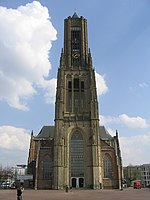Arnhem

Arnhem (Dutch: [ˈɑrnɛm] or [ˈɑr(ə)nɦɛm] ; German: Arnheim; Kleverlandish: Èrnem) is a city and municipality situated in the eastern part of the Netherlands. It is the capital of the province of Gelderland, located on both banks of the rivers Nederrijn and Sint-Jansbeek, which was the source of the city's development. Arnhem had a population of 163,972 on 1 December 2021, which made it one of the larger cities of the Netherlands. Arnhem is home to the Hogeschool van Arnhem en Nijmegen, ArtEZ Institute of the Arts, Netherlands Open Air Museum, Airborne Museum 'Hartenstein', Royal Burgers' Zoo, NOC*NSF and National Sports Centre Papendal. The north corner of the municipality is part of the Hoge Veluwe National Park. It is approximately 55 square kilometres (21 sq mi) in area, consisting of heathlands, sand dunes, and woodlands.
Excerpt from the Wikipedia article Arnhem (License: CC BY-SA 3.0, Authors, Images).Arnhem
1e Wijkstraat, Arnhem
Geographical coordinates (GPS) Address Nearby Places Show on map
Geographical coordinates (GPS)
| Latitude | Longitude |
|---|---|
| N 51.983333333333 ° | E 5.9166666666667 ° |
Address
1e Wijkstraat 2
6828 EA Arnhem
Gelderland, Netherlands
Open on Google Maps










